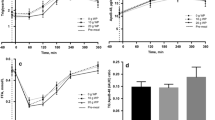Abstract
Purpose
The magnitude of postprandial lipemia is influenced not only by the amount but also the type of fat and carbohydrate consumed. The aim of this study was to evaluate differences in postprandial glucose and lipid responses after a mixed meal containing low- or high-glycemic-index (GI) carbohydrate and three different types of fat varying in the degree of saturation in healthy subjects.
Methods
A randomized, controlled, single-blinded crossover study was conducted in 20 healthy Chinese men. Subjects consumed in random order six experimental isocaloric meals that differed in carbohydrate and fat quality, and contained 40 g of either saturated fat (SFA, butter), monounsaturated fat (MUFA, olive oil) or polyunsaturated fat (PUFA, grapeseed oil), and 50 g of either low-GI (basmati rice) or high-GI (jasmine rice) carbohydrate. Glucose, insulin, c-peptide, triglycerides (TG) and non-esterified fatty acids (NEFA) were measured over 4 h.
Results
For all substrates evaluated, there were no significant interactions between fat and carbohydrate. The incremental area under the curve (iAUC) for TG was significantly lower after the SFA and PUFA meals compared with the MUFA meal, irrespective of GI. No significant difference was found for NEFA iAUC in all treatments. Glucose, insulin and c-peptide iAUCs were significantly lower after ingestion of low-GI than high-GI meals, independent of the type of fat.
Conclusions
A carbohydrate-rich meal (of either low or high GI) that contains butter or grapeseed oil results in lower postprandial TG concentrations relative to olive oil in healthy Chinese males. Glucose, insulin and c-peptide responses, however, are directly dependent on the GI of the meal and not on the degree of saturation of dietary fat.
The trial was registered at clinicaltrials.gov as NCT02585427.




Similar content being viewed by others
References
Yoon KH, Lee JH, Kim JW, Cho JH, Choi YH, Ko SH, Zimmet P, Son HY (2006) Epidemic obesity and type 2 diabetes in Asia. Lancet 368:1681–1688. doi:10.1016/S0140-6736(06)69703-1
Nanditha A, Ma RC, Ramachandran A, Snehalatha C, Chan JC, Chia KS, Shaw JE, Zimmet PZ (2016) Diabetes in Asia and the Pacific: implications for the global epidemic. Diabetes Care 39:472–485. doi:10.2337/dc15-1536
Jenkins DJ, Wolever TM, Taylor RH, Barker H, Fielden H, Baldwin JM, Bowling AC, Newman HC, Jenkins AL, Goff DV (1981) Glycemic index of foods: a physiological basis for carbohydrate exchange. Am J Clin Nutr 34:362–366
Hodge AM, English DR, O’Dea K, Giles GG (2004) Glycemic index and dietary fiber and the risk of type 2 diabetes. Diabetes Care 27:2701–2706
Brand-Miller JC (2003) Glycemic load and chronic disease. Nutr Rev 61:S49–S55
Bhupathiraju SN, Tobias DK, Malik VS, Pan A, Hruby A, Manson JE, Willett WC, Hu FB (2014) Glycemic index, glycemic load, and risk of type 2 diabetes: results from 3 large US cohorts and an updated meta-analysis. Am J Clin Nutr 100:218–232. doi:10.3945/ajcn.113.079533
Ma XY, Liu JP, Song ZY (2012) Glycemic load, glycemic index and risk of cardiovascular diseases: meta-analyses of prospective studies. Atherosclerosis 223:491–496. doi:10.1016/j.atherosclerosis.2012.05.028
Langsted A, Freiberg JJ, Tybjaerg-Hansen A, Schnohr P, Jensen GB, Nordestgaard BG (2011) Nonfasting cholesterol and triglycerides and association with risk of myocardial infarction and total mortality: the Copenhagen City Heart Study with 31 years of follow-up. J Intern Med 270:65–75. doi:10.1111/j.1365-2796.2010.02333.x
Mora S, Rifai N, Buring JE, Ridker PM (2008) Fasting compared with nonfasting lipids and apolipoproteins for predicting incident cardiovascular events. Circulation 118:993–1001. doi:10.1161/CIRCULATIONAHA.108.777334
Nordestgaard BG, Benn M, Schnohr P, Tybjaerg-Hansen A (2007) Nonfasting triglycerides and risk of myocardial infarction, ischemic heart disease, and death in men and women. JAMA 298:299–308. doi:10.1001/jama.298.3.299
Bansal S, Buring JE, Rifai N, Mora S, Sacks FM, Ridker PM (2007) Fasting compared with nonfasting triglycerides and risk of cardiovascular events in women. JAMA 298:309–316. doi:10.1001/jama.298.3.309
Liu J, Zeng FF, Liu ZM, Zhang CX, Ling WH, Chen YM (2013) Effects of blood triglycerides on cardiovascular and all-cause mortality: a systematic review and meta-analysis of 61 prospective studies. Lipids Health Dis 12:159. doi:10.1186/1476-511X-12-159
Schrezenmeir J, Fenselau S, Keppler I, Abel J, Orth B, Laue C, Sturmer W, Fauth U, Halmagyi M, Marz W (1997) Postprandial triglyceride high response and the metabolic syndrome. Ann N Y Acad Sci 827:353–368
Mekki N, Charbonnier M, Borel P, Leonardi J, Juhel C, Portugal H, Lairon D (2002) Butter differs from olive oil and sunflower oil in its effects on postprandial lipemia and triacylglycerol-rich lipoproteins after single mixed meals in healthy young men. J Nutr 132:3642–3649
Tholstrup T, Sandstrom B, Bysted A, Holmer G (2001) Effect of 6 dietary fatty acids on the postprandial lipid profile, plasma fatty acids, lipoprotein lipase, and cholesterol ester transfer activities in healthy young men. Am J Clin Nutr 73:198–208
Higashi K, Ishikawa T, Shige H, Tomiyasu K, Yoshida H, Ito T, Nakajima K, Yonemura A, Sawada S, Nakamura H (1997) Olive oil increases the magnitude of postprandial chylomicron remnants compared to milk fat and safflower oil. J Am Coll Nutr 16:429–434
Thomsen C, Rasmussen O, Lousen T, Holst JJ, Fenselau S, Schrezenmeir J, Hermansen K (1999) Differential effects of saturated and monounsaturated fatty acids on postprandial lipemia and incretin responses in healthy subjects. Am J Clin Nutr 69:1135–1143
Cohen JC, Schall R (1988) Reassessing the effects of simple carbohydrates on the serum triglyceride responses to fat meals. Am J Clin Nutr 48:1031–1034
Mann JI, Truswell AS, Pimstone BL (1971) The different effects of oral sucrose and glucose on alimentary lipaemia. Clin Sci 41:123–129
Saito H, Kato M, Yoshida A, Naito M (2015) The ingestion of a fructose-containing beverage combined with fat cream exacerbates postprandial lipidemia in young healthy women. J Atheroscler Thromb 22:645. doi:10.5551/jat.Erratum22681
Cohen JC, Noakes TD, Benade AJ (1988) Serum triglyceride responses to fatty meals: effects of meal fat content. Am J Clin Nutr 47:825–827
Dubois C, Beaumier G, Juhel C, Armand M, Portugal H, Pauli AM, Borel P, Latge C, Lairon D (1998) Effects of graded amounts (0–50 g) of dietary fat on postprandial lipemia and lipoproteins in normolipidemic adults. Am J Clin Nutr 67:31–38
Radulescu A, Hassan Y, Gannon MC, Nuttall FQ (2009) The degree of saturation of fatty acids in dietary fats does not affect the metabolic response to ingested carbohydrate. J Am Coll Nutr 28:286–295
Lairon D, Play B, Jourdheuil-Rahmani D (2007) Digestible and indigestible carbohydrates: interactions with postprandial lipid metabolism. J Nutr Biochem 18:217–227. doi:10.1016/j.jnutbio.2006.08.001
Jeppesen J, Chen YD, Zhou MY, Wang T, Reaven GM (1995) Effect of variations in oral fat and carbohydrate load on postprandial lipemia. Am J Clin Nutr 62:1201–1205
Collier G, McLean A, O’Dea K (1984) Effect of co-ingestion of fat on the metabolic responses to slowly and rapidly absorbed carbohydrates. Diabetologia 26:50–54
Collier G, O’Dea K (1983) The effect of coingestion of fat on the glucose, insulin, and gastric inhibitory polypeptide responses to carbohydrate and protein. Am J Clin Nutr 37:941–944
Joannic JL, Auboiron S, Raison J, Basdevant A, Bornet F, Guy-Grand B (1997) How the degree of unsaturation of dietary fatty acids influences the glucose and insulin responses to different carbohydrates in mixed meals. Am J Clin Nutr 65:1427–1433
Tan VM, Wu T, Henry CJ, Lee YS (2015) Glycaemic and insulin responses, glycaemic index and insulinaemic index values of rice between three Asian ethnic groups. Br J Nutr 113:1228–1236. doi:10.1017/S0007114515000586
Eberly LE, Stamler J, Neaton JD (2003) Relation of triglyceride levels, fasting and nonfasting, to fatal and nonfatal coronary heart disease. Arch Intern Med 163:1077–1083. doi:10.1001/archinte.163.9.1077
van Greevenbroek MM, Robertus-Teunissen MG, Erkelens DW, de Bruin TW (1998) Participation of the microsomal triglyceride transfer protein in lipoprotein assembly in Caco-2 cells: interaction with saturated and unsaturated dietary fatty acids. J Lipid Res 39:173–185
Jones PJ, Pencharz PB, Clandinin MT (1985) Absorption of 13C-labeled stearic, oleic, and linoleic acids in humans: application to breath tests. J Lab Clin Med 105:647–652
de Bruin TW, Brouwer CB, van Linde-Sibenius Trip M, Jansen H, Erkelens DW (1993) Different postprandial metabolism of olive oil and soybean oil: a possible mechanism of the high-density lipoprotein conserving effect of olive oil. Am J Clin Nutr 58:477–483
Purcell R, Latham SH, Botham KM, Hall WL, Wheeler-Jones CP (2014) High-fat meals rich in EPA plus DHA compared with DHA only have differential effects on postprandial lipemia and plasma 8-isoprostane F2alpha concentrations relative to a control high-oleic acid meal: a randomized controlled trial. Am J Clin Nutr 100:1019–1028. doi:10.3945/ajcn.114.091223
Sun L, Ranawana DV, Leow MK, Henry CJ (2014) Effect of chicken, fat and vegetable on glycaemia and insulinaemia to a white rice-based meal in healthy adults. Eur J Nutr. doi:10.1007/s00394-014-0678-z
Gentilcore D, Chaikomin R, Jones KL, Russo A, Feinle-Bisset C, Wishart JM, Rayner CK, Horowitz M (2006) Effects of fat on gastric emptying of and the glycemic, insulin, and incretin responses to a carbohydrate meal in type 2 diabetes. J Clin Endocrinol Metabol 91:2062–2067. doi:10.1210/jc.2005-2644
Robertson MD, Jackson KG, Fielding BA, Morgan LM, Williams CM, Frayn KN (2002) Acute ingestion of a meal rich in n-3 polyunsaturated fatty acids results in rapid gastric emptying in humans. Am J Clin Nutr 76:232–238
MacIntosh CG, Holt SH, Brand-Miller JC (2003) The degree of fat saturation does not alter glycemic, insulinemic or satiety responses to a starchy staple in healthy men. J Nutr 133:2577–2580
Henry CJ, Lightowler HJ, Newens KJ, Pata N (2008) The influence of adding fats of varying saturation on the glycaemic response of white bread. Int J Food Sci Nutr 59:61–69. doi:10.1080/09637480701664183
Gatti E, Noe D, Pazzucconi F, Gianfranceschi G, Porrini M, Testolin G, Sirtori CR (1992) Differential effect of unsaturated oils and butter on blood glucose and insulin response to carbohydrate in normal volunteers. Eur J Clin Nutr 46:161–166
Pedersen A, Marckmann P, Sandstrom B (1999) Postprandial lipoprotein, glucose and insulin responses after two consecutive meals containing rapeseed oil, sunflower oil or palm oil with or without glucose at the first meal. Br J Nutr 82:97–104
Rasmussen O, Lauszus FF, Christiansen C, Thomsen C, Hermansen K (1996) Differential effects of saturated and monounsaturated fat on blood glucose and insulin responses in subjects with non-insulin-dependent diabetes mellitus. Am J Clin Nutr 63:249–253
Acknowledgments
We thank the volunteers who participated in this trial. The study was supported by the Singapore Institute for Clinical Sciences, A*STAR (Grant No. SPF 2013/003).
Author information
Authors and Affiliations
Corresponding author
Ethics declarations
Conflict of interest
None of the authors has any conflict of interest to declare.
Rights and permissions
About this article
Cite this article
Sun, L., Tan, K.W.J., Lim, J.Z. et al. Dietary fat and carbohydrate quality have independent effects on postprandial glucose and lipid responses. Eur J Nutr 57, 243–250 (2018). https://doi.org/10.1007/s00394-016-1313-y
Received:
Accepted:
Published:
Issue Date:
DOI: https://doi.org/10.1007/s00394-016-1313-y




